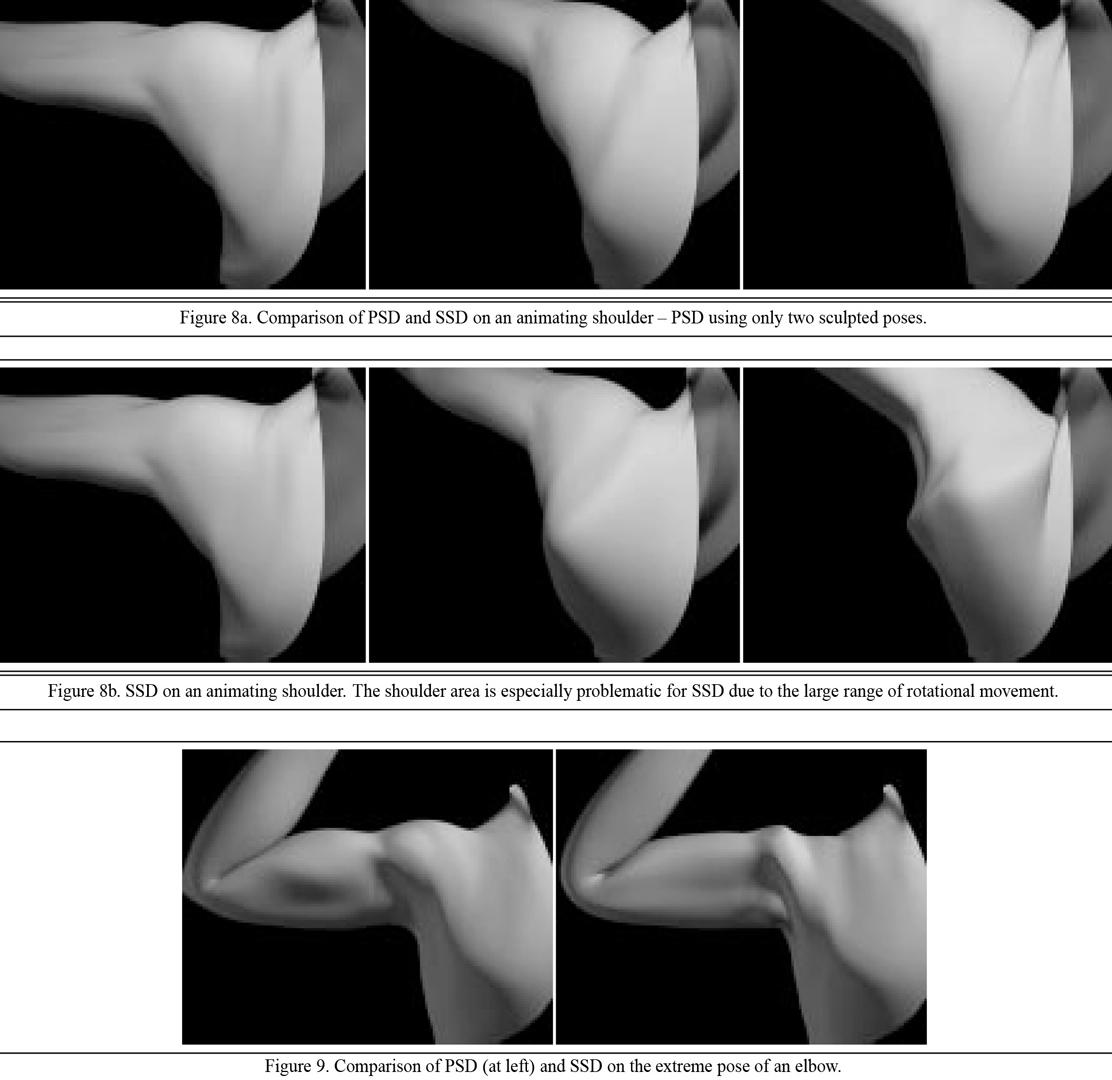“Pose space deformation: a unified approach to shape interpolation and skeleton-driven deformation” by Lewis, Cordner and Fong
Conference:
Type(s):
Title:
- Pose space deformation: a unified approach to shape interpolation and skeleton-driven deformation
Presenter(s)/Author(s):
Abstract:
Pose space deformation generalizes and improves upon both shape interpolation and common skeleton-driven deformation techniques. This deformation approach proceeds from the observation that several types of deformation can be uniformly represented as mappings from a pose space, defined by either an underlying skeleton or a more abstract system of parameters, to displacements in the object local coordinate frames. Once this uniform representation is identified, previously disparate deformation types can be accomplished within a single unified approach. The advantages of this algorithm include improved expressive power and direct manipulation of the desired shapes yet the performance associated with traditional shape interpolation is achievable. Appropriate applications include animation of facial and body deformation for entertainment, telepresence, computer gaming, and other applications where direct sculpting of deformations is desired or where real-time synthesis of a deforming model is required.
References:
1. R. Barnhill, R. Dube, and F. Little, Properties of Shepard’s Surfaces. Rocky Mountain J. Math., vol.13, 1983, pp. 365-382.
2. T. Beier and S. Neely, Feature-Based Image Metamorphosis. Computer Graphics vol. 26, no. 2 (Proc. SIGGRAPH 92), pp 35-42.
3. R Bergeron and R Lachapelle, Controlling Facial Expression and Body Movements in the Computer Generated Short ‘Tony de Peltrie’. SIGGRAPtt 85 Tutorial Notes, ACM, 1985.
4. C. Bishop, Neural Networks for Pattern Recognition, Oxford: Clarendon, 1995.
5. A. Blake and A. Zisserman, VisuaIReconstruction, MIT Press, Cambridge, 1988.
6. N. Burtnyk and M. Wein, Interactive Skeleton Techniques for Enhancing Motion Dynamics in Key Frame Animation, Comm. ACM, vol. 19, no. 10 (October 1976), pp. 564-569.
7. J. Chadwick, D. Haumann, and R. Parent, Layered Construction for Deformable Animated Characters. Computer Graphics vol. 23 no. 3 (Proc. SIGGRAPH 89), pp. 243-252.
8. D.T. Chen and D. Zeltzer, Pump It Up: Computer Animation Based Model of Muscle Using the Finite Element Method. Computer Graphics vol. 26, (Proc. SIGGRAPH 92), pp. 89-98.
9. Cinefex, Riverside, CA, various issues, e.g. vol. 66 (June 1996), p. 52 (Dragonheart); vol. 64 (Dec 1995), p. 62 (Jumanji).
10. T. DeRose, M. Kass, and T. Truong, Subdivision Surfaces in Character Animation. Proc. SIGGRAPH 98, ACM, pp. 85-94.
11. D. Forsey, A Surface Model for Skeleton-Based Character Animation. In Second Eurographics Workshop on Animation and Simulation, Vienna, Austria, 1991, pp. 55-73.
12. W.M. Hsu, J. F. Hughes, and H. Kaufman, Direct Manipulation of Free-Form Deformations, Computer Graphics vol. 26 (Proc. SIGGRAPH 92), pp. 177-184.
13. K. Komatsu, “Human Skin Model Capable of Natural Shape Variation,” The Visual Computer, vol. 4, no. 3, 1988, pp. 265-271.
14. J. R Lewis, Creation by Refinement: A Creativity Paradigm for Gradient Descent Learning Networks. International Conf. on Neural Networks’. San Diego, 1988, Ih 229-233.
15. J.P. Lewis, Probing the Critic: Approaches to Connectionist Pattern Synthesis. IEEE International Joint Conference on Neural Networks’ Seattle, July 1991.
16. R Litwinowicz and L. Williams, Animating Images with Drawings, P~vc. SIG- GRAPH 94, pp. 409-412.
17. R. MacCracken and K. Joy, Free-Form Deformations with Lattices of Arbitrary Topology. P1vc. SIGGRAPH 96, pp. 181-180.
18. G. Maestri, Digital Character Animation 2, Vol 1. New Rider, Indianapolis, 1999. ISBN 1056205-930-0.
19. L. Nedel and D. Thalmann, Modeling and Deformation of the Human Body Using an Anatomically-Based Approach, www preprint.
20. C.W.A.M. van Overveld, A Technique for Motion Specification in Computer Animation, Visual Computer, vol. 6 (1990), p. 106-116.
21. T. Poggio and R. Brunelli. A novel approach to graphics. AI Memo 1354, C.B.hP Paper 71, MIT, 1992.
22. K. Singh and E. Fiume, Wires: A Geometric Deformation Technique. P~vc. SIG- GRAPH 98, ACM, pp. 405-414.
23. N. Magnenat-Thalmann, R. Laperriere, and D. Thalmann. Joint-Dependent Local Deformations for Hand Animation and Object Grasping. P~vc. Graphics Intelface, 1988, pp. 26-33.
24. N. Magnenat-Thalmann and D. Thalmann. Human Body Deformations using Joint-Dependent Local Operators and Finite Element Theory. In N. Badler, B. Barsky, and D. Zeltzer, eds., Making Them Move: Mechanics, Cont~vl, and Animation of Articulated Figures San Mateo, CA: Morgan Kaufmann, 1991, pp. 243-262.
25. Maya Alias/Wavefront, Santa Barbara, CA, 1998.
26. F. h Parke, Parameterized Models for Facial Animation. IEEE Computer Graphics and Applications, vol. 2, no. 9, November 1982, pp. 61-68.
27. S. Pieper, Physically-Based Animation of Facial Tissue for Surgical Simulation, SIGGRAPH 89 Tutorial Notes: State of the Art in FaciaI Animation, ACM, 1989.
28. J.D. Powell, The Theory of Radial Basis Function Approximation. Cambridge University Numerical Analysis Report, 1990.
29. M.J.D. Powell, Radial Basis Functions for Multivariable Interpolation: A Review. In J. Mason and M. Cox, Eds., Algorithms for Approximation, Oxford: Clarendon, pp. 143-167.
30. J.A. Russel, A Circomplex Model of Affect. J. Personality and Social Psychology, vol. 39, p. 1161-1178, 1980.
31. F. Scheepers, R. Parent, W. Carlson, and S. May, Anatomy-Based Modeling of the Human Musculature. P~vc. SIGGRAPH 97, ACM, pp. 163-172.
32. T. Sederberg and S. Parry, Free Form Deformations of Solid Geometric Models. Computer Graphics, vol. 20 no. 4, (Proc. SIGGRAPH 86), pp. 150-161.
33. B. Shneiderman, The Future of Interactive Systems and the Emergence of Direct Manipulation. Behaviour and Information Technology, 1, pp. 237-356.
34. Pat Taylor, Disney/Dream Quest Mighty Joe Young facial animation, personal communication.
35. R. Turner and D. Thalmann, The Elastic Surface Layer Model for Animated Character Construction. in N. M. Thalmann and D. Thalmann, eds., P~vc. Computer Graphis International, New York: Springer Verlag, 1993, pp. 399-412.
36. J. Wilhelms and A. Van Gelder, Anatomically Based Modeling. P~vc. SIG- GRAPH 97, pp. 173-180.
37. G. Wyvill, C. McPheeters, and B. Wyvill, Animating Soft Objects. Visual Compute~, 2, 235-242, 1986.
38. Xinmin Zhao, Disney Dinosaur project, personal communication.





